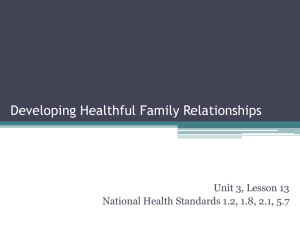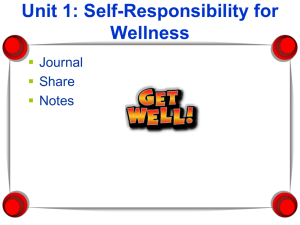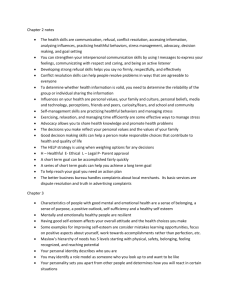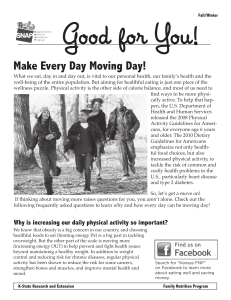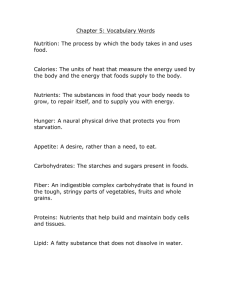MADISON PUBLIC SCHOOLS HEALTH – Grade 4
advertisement
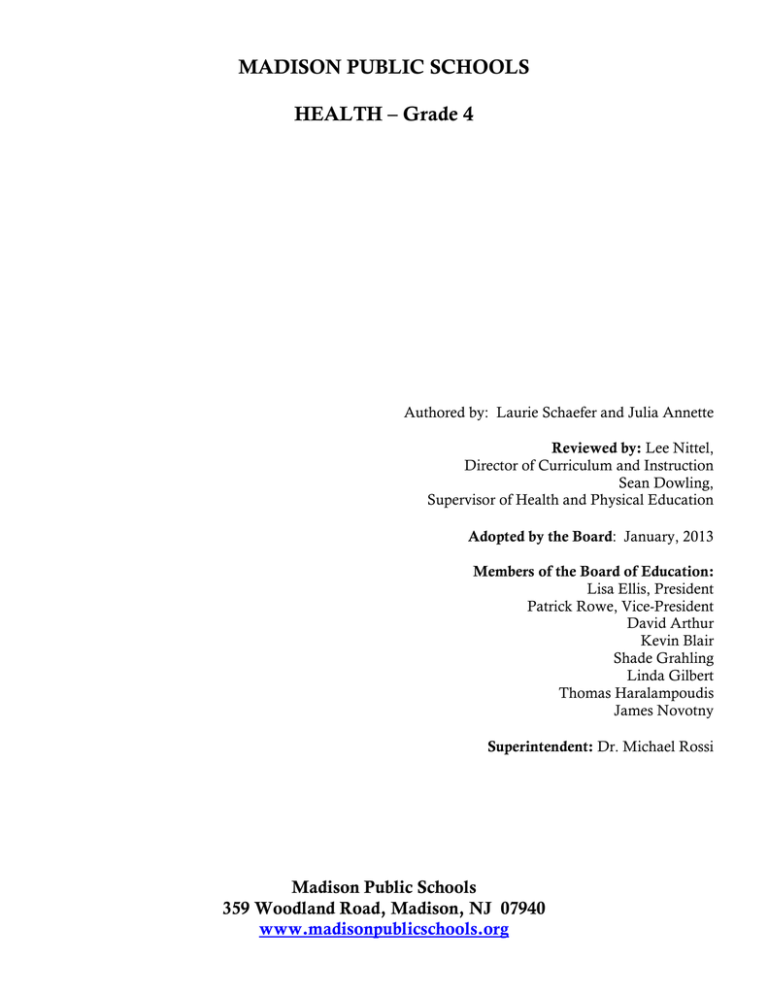
MADISON PUBLIC SCHOOLS HEALTH – Grade 4 Authored by: Laurie Schaefer and Julia Annette Reviewed by: Lee Nittel, Director of Curriculum and Instruction Sean Dowling, Supervisor of Health and Physical Education Adopted by the Board: January, 2013 Members of the Board of Education: Lisa Ellis, President Patrick Rowe, Vice-President David Arthur Kevin Blair Shade Grahling Linda Gilbert Thomas Haralampoudis James Novotny Superintendent: Dr. Michael Rossi Madison Public Schools 359 Woodland Road, Madison, NJ 07940 www.madisonpublicschools.org II. OVERVIEW The Elementary Health Education Curriculum is designed to teach students the information and skills they need to become health-literate, to maintain and improve health, prevent disease, and reduce health-related risk behaviors. Through this curriculum, students will develop critical thinking, problem solving, and communication skills. In addition, the students will demonstrate good character and behaviors that promote a healthy community, nation, and world. II. RATIONALE This Health Education Curriculum is designed to give students in grades K-6 the opportunity to develop health knowledge, practice life skills, and work to achieve health goals that protect them from risk behaviors. Upon completion, students will ascertain knowledge and skills in the following health related areas: mental, emotional, family, and social health; growth and nutrition; personal health and safety; drugs and disease prevention; community and environmental health. III. STUDENT OUTCOMES (Linked to NJ Core Curriculum Standards Listed Below) A. Students will recognize the body’s reaction to stress and explain ways to manage stress. (2.1) B. Students will identify the characteristics of healthy friendships and ways to deal with those who are unkind.(2.1, 2.4) C. Students understand the importance of being well-groomed. (2.1) D. Students will learn about the human anatomy, as well as the stages of growth and development throughout the life cycle. (2.1) E. Students will learn about food labels, and use them to make responsible and healthful food choices. (2.1) F. Students will identify ways to stay safe in a number of situations. (2.1) G. Students will learn the implications of using drugs. (2.3) H. Students will understand the importance of using resistance skills when making choices about drugs. (2.1, 2.2, 2.3) I. Students should understand the differences between communicable and noncommunicable diseases and acute and chronic diseases. (2.1) J. Students will explain how the body’s defenses work and identify medical treatments for various diseases. (2.1) NJ Core Curriculum Content Standards for Comprehensive Health and Physical Education 2.1 All students will learn and apply health promotion concepts and skills to support a healthy, active lifestyle. 2.2 All students will use health-enhancing personal, interpersonal, and life skills to support a healthy, active lifestyle. 2.3 All students will learn and apply information about alcohol, tobacco, other drugs and medicines to make decisions that support a healthy, active lifestyle. 2.4 All students will learn the physical, emotional, and social aspects of human relationships and sexuality and apply these concepts to support a healthy, active lifestyle. IV. ESSENTIAL QUESTIONS Chapter 1 Mental and Emotional Health How might a person’s body react under stress? What are the four steps to follow in order to manage stress? What three actions can you take to show a positive attitude? Chapter 2 Family and Social Health How does a true friend act? What should you do if a friend tries to pressure you into doing something wrong? What is peer pressure? What are some healthful ways to develop a new friendship? What should you do when you feel left out? How can you protect yourself against abuse? Chapter 3 Growth and Development How is the body organized? How do the body systems work together? What are some parts of the digestive system? What happens to food during digestion? What organs make up the nervous system? How can you protect your nervous system? What are hormones, and how do they affect growth? Describe the changes that happen during each stage of the life cycle. What are the ways to age healthfully? Chapter 4 Nutrition Why is it important to know how to read food labels? What appeals are found in food and beverage ads? How can you eat healthfully at fast food restaurants? What is a balanced diet? What guidelines can help you choose healthful meals and snacks? Chapter 6 Violence and Injury Protection How can you stay safe from strangers, at home, at school, and in the community? How can you protect yourself from an unsafe touch? Why is it important to your health and the health of others not to touch a weapon? What are some reasons to stay away from gangs? Chapter 7 Alcohol, Tobacco, and Other Drugs How can marijuana harm your health? How can the misuse or abuse of stimulants or depressants harm your health? Why is it harmful to abuse inhalants and steroids? What are some reasons to say NO to drug abuse? What strategies help you to say NO to abusing drugs? Who are some healthcare helpers who might be useful to people who are giving up drug abuse? Chapter 8 Communicable and Chronic Diseases What kinds of pathogens cause disease? How do pathogens get into the body? What are some healthful habits that keep germs from spreading? How do the body’s defenses work? What are symptoms and signs of diseases? How are certain diseases treated? What are the four main causes of chronic diseases? What is diabetes? What are some causes of allergies and ways to reduce the risk of allergy attacks? What are some common asthma triggers, and how can they be reduced? V. STRATEGIES Development of concepts will take place through teacher guided lessons that may incorporate (but not be limited to) any of the following: reading, writing, discussions, hands-on activities, role play, art projects, and demonstrations. Class discussions and activities will develop decision-making skills, effective communication and listening skills, and critical thinking. Activities may take place as individual, small group, or whole class. VI. EVALUATION Assessment may include: • Notebooks • Student projects • Student journals • Participation Optional: • Homework • Teacher-made quiz/test VII. REQUIRED RESOURCES Meeks & Heit, Health and Wellness Teacher Edition Grade 4, Macmillan/McGraw-Hill, 2008. Meeks & Heit, Health and Wellness Student Edition Grade 4, Macmillan/McGraw-Hill, 2008. Supplemental Teacher Resources (Macmillan/McGraw-Hill) You and Your Body Delta Science Kit VIII. SCOPE AND SEQUENCE In recognizing that there are various teaching and learning styles, please select activities for each health lesson that would be best suited for your class. Each lesson has Health Masters pages, a lesson quiz, leveled activities, and other cross-curricular activities listed within the teachers’ edition. Activities should be used to enhance lessons and/or as follow-up activities (i.e. homework, morning work, etc. Chapters 3 and 4 should be incorporated into the 4th grade You and Your Body Science Unit where appropriate. Chapter 1 Mental and Emotional Health (1 period) Content: • Stress and your health • Managing stress 1) Lesson 6 (Reducing Stress) TE pages A32-A37 Text pages A32-A37 Chapter 2 Family and Social Health (1 period) Content: • • • • • Friendship Peer pressure Developing new friendships Feeling left out Protecting yourself against abuse 1) Lessons 5 and 6 (Healthful Friendships/When Others are Unkind) TE pages A68-A77 Text pages A68-A77 Transparency 5 Chapter 3 Growth and Nutrition (4 periods) Content: • Body systems • Parts of the digestive system • Understanding digestion • Parts of the nervous system • Protecting your nervous system • Hormones and growth • Stages of the life cycle 1) Lesson 1 (Your Body Systems) ***This lesson could be used as an introduction to You and Your Body Science Unit*** TE pages B4-B7 Text pages B4-B7 Transparency 6 2) Lesson 3 (More Body Systems) (ONLY digestive and nervous systems) TE pages B15, B18-19 Text pages B15, B18-19 Transparencies 9 and 12 3) Lesson 4 (Stages of the Life Cycle) TE pages B20-B25 Text pages B20-B25 4) Lesson 5 (Your Future Growth) TE pages B26-31 Text pages B26-31 Chapter 4 Nutrition (3 periods) Content: • Reading food labels • Food ads • A balanced diet • Guidelines for choosing healthful meals and snacks 1) Lesson 3 (Food Labels and Food Ads) TE pages B50-B53 Text pages B50-B53 Transparencies 17, 18 2) Lesson 4 (Eating Healthful Meals and Snacks) TE pages B 50-B53 Text pages B50-B53 3) Lesson 6 (A Healthful Weight) TE pages B66-B69 Text pages B66-B69 Chapter 6 Violence and Injury Prevention (1 period) Content: • Staying safe from violence, weapons, gangs, and strangers • Unsafe touch 1) Lessons 4 and 5 (Being Safe from Violence/Being Safe from Gangs) TE pages C64-C73 Text pages C64-C73 Chapter 7 Alcohol, Tobacco, and Other Drugs (2 periods) Content: • Effects of marijuana • Effects of stimulants, depressants, inhalants, and steroids • Refusal skills • Healthcare helpers 1) Lesson 4 (Drug Abuse) TE pages D24-D29 Text pages D24-D29 Transparency 38 2) Lesson 5 (Stay Drug Free) TE pages D30-D33 Text D30-D33 Chapter 8 Communicable and Chronic Diseases (3 periods) Content: • Pathogens • Preventing the spread of germs • Signs and symptoms of diseases • Treatment of diseases • Chronic diseases • Diabetes • Allergies and asthma 1) Lesson 1 (Diseases that Spread) TE pages D38-D43 Text pages D38-D43 Transparency 39 2) Lessons 2 and 3 (The Body’s Defense/Treating Disease) TE pages D44-D53 Text pages D44-D53 3) Lesson 4 (Chronic Diseases) TE pages D 56-61 Text pages D56-61 Transparency 11
